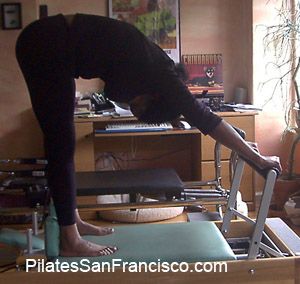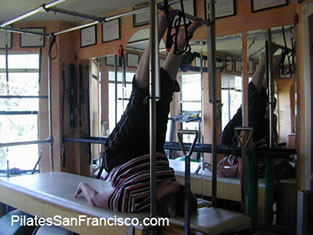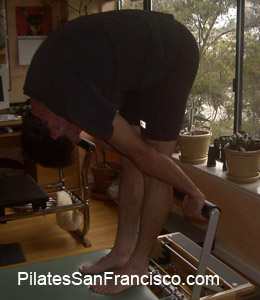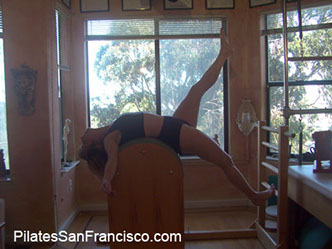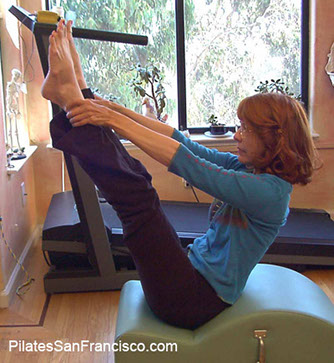PILATES SAN FRANCISCO
Some clients (and especially men) have a predisposition to
tight hamstrings.
Almost everyone can achieve improvement.
Evaluation:
Check standing alignment.
Weight should be placed between the front of the heel to the back of the ball of the foot.
Standing with weight at the back of the heel with locked knees stresses hamstrings.
Check sitting alignment:
Cue client to keep seated weight on between the front and mid sitz bones.
Recommend ergonomic seating for the computer-bound and use pillows and wedges to help during seated exercises.
Many clients learn to find their sitz bones while seated on a fitness ball.
Tight hamstrings are not necessarily strong and you must remember to work on strengthening and stretching at the same time.
For instance: cramping during a bridging exercise might mean that the hamstrings are tired and stressed or that they are very weak.
Remember to continue stretching and strengthening the quads, calves, IT band, ankles and feet as you address the hamstrings.
It all works together.
Exercises:
These exercises are ones that most clients can do successfully.
Against the wall:
Stand on slant board with heels against the wall. Slowly bend to flat back from the hip crease.
6” Roller:
Marching and dead bug.
Foot as a fish
Bridging
Psoas stretch
Tissue release/massage (sitting with weight on hands)
Cadillac/trap table:
Shoulder stand
Hamstring tower
Monkey
Parakeet
Sissors
Legsprings
Ballet stretches in sling
Bridging in sling (straight knees)
Ladder Barrel:
Climb a tree
Ballet stretches
Step Barrel
V-sit
Shoulder stand
Leg circles
Airplane
Can can
Reformer
Legwork
Releves and running
Leg circles in straps
Shortspine
Stomach massage 1 & 2
Ham stretch in straps
Bridging
Side lying legwork
Psoas stretch (Eve's lunge)
Scooter
Climb a tree
Split
Elephant
Upstretch
Arabesque
Tendon Stretch
Mat:
Stretch with theraband or fitness band
Rollup
Sitz bone walk
V-sit
Pilates Chair:
Ham stretch 1 & 2
Tendon stretch
Upstretch
Foot and Legwork
Reminders:
Tight hamstrings are a very common complaint among many different kinds of clients – the super athletic to the sedentary. It is extremely important to keep the hamstrings long and supple. The muscle shortness can indicate not just overuse but the even more serious issue of an extremely tucked pelvis which can lead to low back complications.
Posture -- both sitting and standing -- is often the cause of the problem.
Core exercises are vital to improvement.
